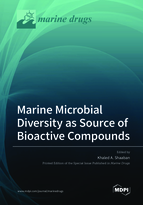Marine Microbial Diversity as Source of Bioactive Compounds
A special issue of Marine Drugs (ISSN 1660-3397).
Deadline for manuscript submissions: closed (31 October 2021) | Viewed by 31046
Special Issue Editor
Interests: natural products chemistry; lead/probe discovery and development; infectious disease; antibiotics and anticancer; chromatography; NMR spectroscopy and mass spectrometry; complex NP structure elucidation; biosynthesis
Special Issues, Collections and Topics in MDPI journals
Special Issue Information
Dear Colleagues,
Over 70% of the Earth’s surface is covered by oceans and seas, which are massively complex and consist of diverse assemblages of life forms. Marine bacteria, fungi, and other microorganisms develop unique metabolic and physiological capabilities that enable them to survive in extreme habitats and to produce compounds that might not be produced by their terrestrial counterparts. In the last few decades, the systematic investigations of marine/marine-derived microorganisms as sources of novel biologically active agents has exponentially increased. This Special Issue will focus on aspects relating to new bioactive metabolites from marine microorganisms including the isolation, taxonomy, and/or dereplication of microorganisms and the corresponding isolation, structure elucidation, biosynthesis, and/or biological activities of the new compounds. Comprehensive topical review articles relating to marine metabolites will also be considered.
Prof. Dr. Khaled A. Shaaban
Guest Editor
Manuscript Submission Information
Manuscripts should be submitted online at www.mdpi.com by registering and logging in to this website. Once you are registered, click here to go to the submission form. Manuscripts can be submitted until the deadline. All submissions that pass pre-check are peer-reviewed. Accepted papers will be published continuously in the journal (as soon as accepted) and will be listed together on the special issue website. Research articles, review articles as well as short communications are invited. For planned papers, a title and short abstract (about 100 words) can be sent to the Editorial Office for announcement on this website.
Submitted manuscripts should not have been published previously, nor be under consideration for publication elsewhere (except conference proceedings papers). All manuscripts are thoroughly refereed through a single-blind peer-review process. A guide for authors and other relevant information for submission of manuscripts is available on the Instructions for Authors page. Marine Drugs is an international peer-reviewed open access monthly journal published by MDPI.
Please visit the Instructions for Authors page before submitting a manuscript. The Article Processing Charge (APC) for publication in this open access journal is 2900 CHF (Swiss Francs). Submitted papers should be well formatted and use good English. Authors may use MDPI's English editing service prior to publication or during author revisions.
Keywords
- natural products discovery
- marine microorganisms (bacteria, fungi, microalgae, etc.)
- taxonomy
- fermentation
- secondary metabolites
- extraction, isolation, purification, and structure elucidation
- biological activities (anticancer, antimicrobial, antiviral, etc.)
- biosynthesis







